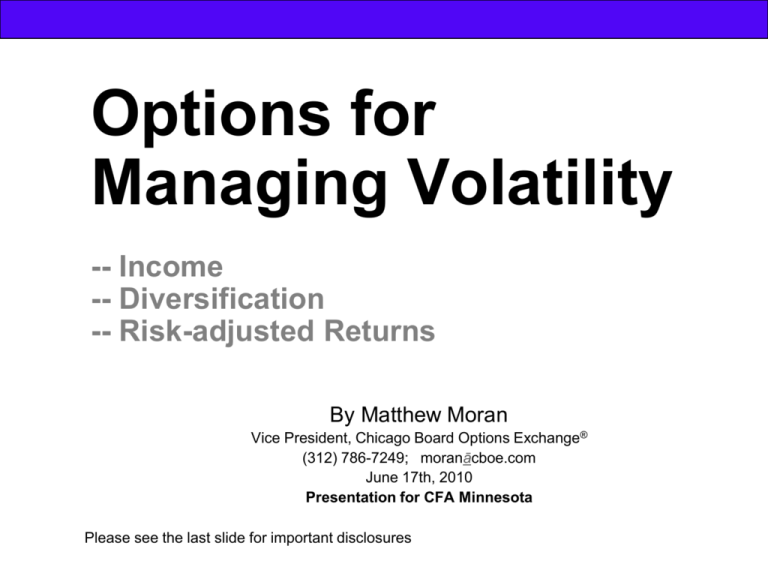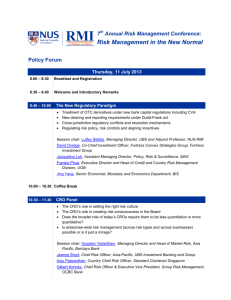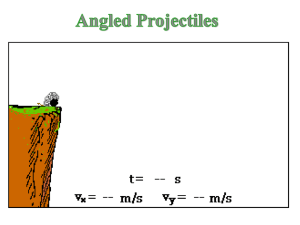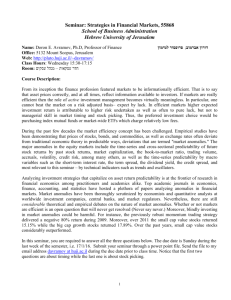
Options for
Managing Volatility
-- Income
-- Diversification
-- Risk-adjusted Returns
By Matthew Moran
Vice President, Chicago Board Options Exchange®
(312) 786-7249; moranācboe.com
June 17th, 2010
Presentation for CFA Minnesota
Please see the last slide for important disclosures
16 Challenging Months
Little diversification as stock and commodity indexes fell by more than 50%
Month-end values of indexes,
re-scaled to 1 as of Oct. 31, 2007
1.6
1.4
1.2
-51%
S&P 500
-52%
Russell 2000
1.0
0.8
0.6
-53%
SP GSCI
(commodity)
-54%
MSCI World Index
Net US$
0.4
(Oct. 31, 2007 - Feb. 28, 2009)
Sources: CBOE and Bloomberg Total return indexes
Feb-09
Dec-08
Oct-08
Aug-08
Jun-08
Apr-08
Feb-08
Dec-07
Oct-07
0.2
US pension law
requires pension
fiduciaries to diversify
so as to minimize the
risk of large losses
2
Month-end values of indexes,
re-scaled to 1 as of Oct. 31, 2007
16 Challenging Months for Alternatives
1.1
1.0
0.9
0.8
0.7
0.6
0.5
0.4
0.3
0.2
0.1
Feb-09
Dec-08
Oct-08
Aug-08
Jun-08
Apr-08
Feb-08
Dec-07
Oct-07
-22%
Hedge Fund - CISDM
-25%
High-Yield Bond (CS)
-26%
-51%
20-metro Home Price
Index
Russell 3000
-54%
MSCI EAFE
-62%
MSCI Emerging Mkts
-80%
Private Equity
(Oct. 31, 2007 - Feb. 28, 2009)
Sources: CBOE and Bloomberg Total return indexes are used
for stocks. S&P Case-Shiller Home Price Index and S&P Private
Equity Index are used.
3
Harry Markowitz and
Modern Portfolio Theory (MPT) -“[in 2008] the S&P 500 fell approximately 38.5%; the higherbeta emerging-markets asset class fell much farther.
Corporate bonds fell in value, but much less than equities,
and government bonds went up. … Generally, asset
classes moved roughly in proportion to their historical betas.
… MPT never promised high return with low risk. … [u]nless
our portfolios are comprised entirely of short-term
government bonds, we’ll be dealing with a level of risk for
which MPT prescribes following an old and true adage:
‘Don’t put all your eggs in one basket.’”
The Investment Professional magazine (Spring 2009)
16 Challenging Months
Can volatility diversify and lessen portfolio volatility?
Month-end values of indexes,
re-scaled to 1 as of Oct. 31, 2007
3.5
3.0
194%
2.5
150%
VIX Short-Term
Futures Idx S&P
VIX - Spot Volatility
2.0
1.5
25%
1.0
0.5
S&P 500
Feb-09
Dec-08
Oct-08
Aug-08
Jun-08
Apr-08
Feb-08
Dec-07
Oct-07
0.0
-51%
Citigroup 30-yr
Treasury
(Oct. 31, 2007 - Feb. 28, 2009)
Sources: CBOE and Bloomberg
5
Diversification over
a 23-month Time Period
Month-end Prices, Re-scaled to 1
on Oct. 31, 2007
23 Months
3.5
3.0
2.5
VIX - CBOE
Volatility Index
2.0
1.5
1.38
1.0
0.5
0.71
0.70
0.57
0.0
S&P 500
MSCI World
Index Net US$
Apr-09
Oct-08
Apr-08
Oct-07
SP GSCI TR
(Oct. 31, 2007 - Sep. 30, 2009)
Sources: CBOE and Bloomberg
6
30 Months for Select Indexes
Month-end values of indexes,
re-scaled to 1 as of Oct. 31, 2007
1.6
1.4
1.2
1.01
Citigroup 30-yr
Treasury
1.00
PUT - CBOE S&P 500
PutWrite Index
0.6
0.81
S&P 500
0.4
0.63
S&P GSCI
1.0
0.8
Apr-10
Oct-09
Apr-09
Oct-08
Apr-08
Oct-07
0.2
(Oct. 31, 2007 - April 30, 2010)
Sources: CBOE and Bloomberg Total return indexes
7
Higher Correlations for Stock Indexes
Rolling One-Year Correlations
of Weekly Returns of Indexes to the S&P 500
0.93
0.85
0.83
1.0
0.5
0.0
Russell
2000
MSCI EAFE
MSCI
Emerging
-0.5
-0.68
VXO
-1.0
Jan-07
Jan-98
Jan-89
Jan-80
Jan-71
Sources: Bloomberg and CBOE.
(Jan. 1, 1971 - April 16, 2010)
8
Higher Correlations for Alternatives Indexes
Rolling One-Year Correlations
of Weekly Returns of Indexes to the S&P 500
1.0
0.8
0.6
0.4
0.2
0.0
-0.2
-0.4
-0.6
-0.8
-1.0
0.83
0.76
0.72
S&P Private
Equity
DJ REIT
S&P GSCI
-0.67
VIX
Jan-07
Jan-98
Jan-89
Jan-80
Jan-71
Sources: Bloomberg and CBOE.
(Jan. 1, 1971 - April 16, 2010)
9
Correlations and Fixed Income Indexes
Rolling One-Year Correlations
of Weekly Returns of Indexes to the S&P 500
1.0
0.71
Citi HighYield
0.01
Citi BIG
Index
0.5
0.0
-0.36
-0.5
-0.67
30-Yr
Treasury
-1.0
Jan-07
Jan-98
Jan-89
Jan-80
Jan-71
VIX
Sources: Bloomberg and CBOE.
(Jan. 1, 1971 - April 16, 2010)
10
Exchange Listed Equity Options
Calls – Right to buy security at certain price for certain period
Puts – Right to sell security at certain price for certain period
Usually represents 100 shares
Limited life – usually expires after third Friday
Option Info – 200 XYZ Jan 50 calls for 1.55
Number of contracts
Underlying Security
Expiration Date
Strike price
Call / Put
Premium
11
Simple Options Profit-and-Loss Diagrams
Long call gives the holder the
right to buy the underlying
security at a specified price for a
certain, fixed period of time.
Protective put investor
purchases a put (right to sell)
while holding underlying
security.
* The colored line reflects a position with both options and stock
Buy-write investor buys a
security and writes (sells) a
covered call for income
12
Some Key CBOE Options in Jan. 2010
Options
Symbol
CBOE Options Product
Index Options
SPX
S&P 500 Index
Put Avg. Daily
Volume
Call Avg. Daily
Volume
Pu/Call Ratio for
January Volume
451,605
65,773
30,430
275,686
170,977
22,132
1.64
0.38
1.37
VIX
CBOE Volatility Index (options)
RUT
Russell 2000 Index
OEX
S&P 100 Index (American-Style Exercise)
24,559
17,856
1.38
NDX
Nasdaq 100 Index
DJX
Dow Jones Industrial Average
19,249
8,068
14,495
6,601
1.33
1.22
118,929
89,928
57,264
41,139
32,876
38,824
32,234
25,113
24,463
15,228
19,770
15,310
15,398
16,340
16,349
0.30
0.52
0.58
0.49
0.72
0.32
0.59
0.74
0.71
1.46
0.58
1.02
0.77
0.65
0.60
Equity Options
C
Citigroup, Inc.
BAC
Bank of America Corporation
AAQ
Apple, Inc.
INQ
Intel Corporation
JPM
JPMorgan Chase & Co.
MQF
Microsoft Corporation
GE
F
GS
YUX
AA
General Electric Company
Ford Motor Company
The Goldman Sachs Group, Inc.
YRC Worldwide, Inc.
ALCOA, Inc.
WFC
Wells Fargo & Company
ZQN
Amazon.Com, Inc.
GOQ
Google, Inc.
RUL
Research in Motion Limited
35,751
46,485
33,265
20,099
23,630
12,389
18,948
18,458
17,281
22,167
11,560
15,692
11,891
10,682
9,779
Sources: CBOE and www.cboe.com/data
13
Put/call Ratios
Put/call Ratios for CBOE Options
Rolling 20-day ratios of Put/call Volumes
2.5
2.0
Index Options
1.5
Equity Options
1.0
VIX options
0.5
0.0
29-Nov-2006
29-Nov-2007
29-Nov-2008
(Nov. 29, 2006 - May 17, 2010)
29-Nov-2009
Source: www.cboe.com/data
14
Historic Volatility Since 1900
30-day historic volatility for U.S. stock indexes
(DJIA 1900-27, and S&P 500 for 1928 thru Sep. 2009)
100
96.53 on
Nov. 29, 1929
87.50 on
Nov. 20, 1987
80.85 on
Nov. 14, 2008
80
60
40
20
0
Jan-00
Jan-20
Jan-40
Jan-60
Jan-80
Jan-00
(Jan. 1900 - May 14, 2010) Source: Bloomberg
“Historic Volatility” is a measure of actual price changes during a specific time period in the past.
Mathematically, historic volatility is the annualized standard deviation of daily returns during a specific past period.
Mean
Median
High
Low
15.8
13.2
96.5
3.2
15
Implied Volatility Indexes Since 1986
Indexes Measuring 30-day Implied Volatility
(Jan. 2, 1986 - Nov. 2, 2009)
160
Daily Closing Values
150.19 VXO on
Oct. 19, 1987
120
100.42 OVX on
Dec. 11, 2008
80.86 VIX on
Nov. 20, 2008
80
VIX - CBOE
Volatility Index
VXO - CBOE
S&P 100
Volatility Index
(pre-1990)
40
21-Feb-2006
30-Jan-2001
18-Jan-1996
10-Jan-1991
2-Jan-1986
0
OVX - CBOE
Crude Oil
Volatility Index
Source: Bloomberg
“Implied Volatility” is a measure of the option market’s expectations for the future volatility of the underlying security. It is determined by using option prices
currently existing in the market at the time (rather than using historical data on the price changes of the underlying stock or index). It is the annualized volatility
implied by the market price of the option based on an option pricing model. If a 30-day option and a one-year option both have implied volatilities of 25, that
means that the options prices imply that options investors believe that there is about a 68% chance that the price of the underlying will be approximately -(a) within 25% (or one standard deviation) of its current price one year from now, and
(b) within 7.3% (or one standard deviation) of its current price one month from now. (The annualized number of 25% is divided by (the square root of 12)).
16
VIX and S&P 500 Indexes
90
1800
60
1200
30
600
SPX
VIX Daily Closing Prices
S&P 500 (SPX)
VIX
0
0
2-Jan-1990
3-Jan-1995
5-Jan-2000
19-Jan-2005
28-Jan-2010
Sources: CBOE and Bloomberg. (Jan. 2, 1990 - May 14, 2010).
www.cboe.com/VIX
CBOE Volatility Index (VIX)
Average daily closing value in each of 20 years
31.5
2008
2009
2006
32.7
12.8
2005
17.5
12.8
15.5
22.0
2002
2000
27.3
23.3
1999
2001
24.4
1998
1995
25.6
22.4
12.4
1994
16.5
13.9
1993
15
12.7
15.4
20
18.4
25
23.1
30
25.8
35
10
5
0
2007
2004
2003
1997
1996
1992
1991
1990
Sources: CBOE and Bloomberg
17
Worldwide Volatility Indexes – Weekly Highs
100
OVX - CBOE Crude Oil Volatility Idx
80
60
VIX - CBOE Volatility Index
40
GVZ - CBOE Gold Volatility Index
20
EVZ - CBOE EuroCurrency Volat Idx
0
16-May-2008
16-Apr-2009
16-Mar-2010
90
VSTOXX - EuroSTOXX 50 Volatility
60
VCAC - CAC 40 Volatility Idx
30
INVIX - India VIX Index
0
16-May-2008
16-Apr-2009
16-Mar-2010
(May 16, 2008 - May 14, 2010) Sources: CBOE and Bloomberg
18
Key Features of VIX
High Volatility of Volatility
Historic Volatility of Daily Returns
132.0%
94.2%
83.3%
78.5%
45.8%
2005
VIX
(spot)
127.3%
88.9%
88.9%
69.2%
56.0%
2006
2007
2008
VIX Nearterm
Futures
2009
Negative Correlations
of Daily Returns for VIX vs. S&P 500
-0.75
-0.83
-0.82
2005
2006
-0.85
-0.84
2007
2008
2009
Sources: CBOE and Bloomberg
19
Recent VIX Futures & Call Options
VIX and VIX Futures
% Change in Daily Closing
Prices from May 3rd to May 7th –
S&P 500 Down 7.6%
50
Daily Closing Values
Four Days --
VIX Index
VIX Index Up 103%
30
VIX May '10
Futures
VIX May Fut. Up 60%
20
VIX Sept '10
Futures
40
VIX Sept. Fut. Up 23%
10
15-Apr-2010
Daily Closing Price
9
1-May-2010
17-May-2010
VIX May 2010 Call Options
6
3
VIX May25 Calls Up 865%
25 Strike Price
VIX May30 Calls Up 1233%
30 Strike Price
VIX May35 Calls Up 1580%
35 Strike Price
0
15-Apr-2010
1-May-2010
(April 15, 2010 - May 17, 2010)
Sources: CBOE and Bloomberg
17-May-2010
Please read the risk
disclosure at the last slide
20
VIX Term Structure on April 14, 2010
(May 2010 – Dec. 2011)
Expectations of VIX in future months
www.cboe.com/VIX
24.42 at
Dec. 17, 2011
expiration
15.88 mid at May 22, 2010 expiration
VIX closed at 15.59 on April 14, 2010
21
Impact of Adding Long VIX Futures or Options
to a Traditional Portfolio During the 5-Month Period Aug. 2008 – Dec. 2008
From: "VIX Futures and Options: A Case Study of Portfolio Diversification During the 2008 Financial
Crisis." The Journal of Alternative Investments (Fall 2009)
0% VIX Futures or Options
-19.7%
2.5% VIX Futures
-15.9%
10% VIX Futures
-4.0%
3% ATM VIX Call Options
3% 25%-OTM VIX Call Options
Please see disclaimers at paper at www.cboe.com/VIX
20.8%
97.2%
22
UMass Study on Diversification with VIX Futures & Options
With a 10%
allocation to VIX
futures (in black),
returns increased
by 3.5 percentage
points and standard
deviation cut by
one-third.
From: “VIX Futures and Options - A Case Study of Portfolio Diversification During the 2008 Financial Crisis” (published in The Journal of
Alternative Investments in 2009) by Edward Szado, CFA, Research Analyst at the Center for International Securities and Derivatives
Markets (CISDM), University of Massachusetts, Amherst
23
CBOE Performance Benchmark Indexes
Index
Ticker
Introduced
CBOE S&P
500 BuyWrite
BXMSM
2002
CBOE S&P 500
BXYSM
2006
Russell
2000 BuyWrite
BXRSM
2006
CBOE DJIA
BXDSM
2005
BXNSM
2005
CLL
2%OTM BuyWrite
CBOE
BuyWrite
CBOE
NASDAQ-100
Data beginning
Website
June 30, 1986
www.cboe.com/BXM
June 1, 1988
www.cboe.com/BXY
Dec. 29, 2000
www.cboe.com/BXR
Oct. 16, 1997
www.cboe.com/BXD
Dec. 30, 1994
www.cboe.com/BXN
2008
June 30, 1986
www.cboe.com/CLL
2007
June 30, 1986
www.cboe.com/PUT
BuyWrite
CBOE S&P 500
95-110 Collar
CBOE S&P 500
PutWrite
SM
PUT
SM
Bloomberg provides historical data for all seven indexes.
24
What is a “Buy-write”?
Buy stocks, and write (or sell) a call option to
gain premium income.
Also known as a “covered call.”
Pros – add premium income, can reduce
portfolio volatility and boost risk-adjusted
returns.
Cons – forego some or all of the upside on
stock position; underperformance in bull
market.
25
CBOE S&P 500 BuyWrite Index (BXM)
Benchmark for strategy -
buy portfolio of S&P 500 stocks
write (sell) cash-settled S&P 500 Index
options every 3rd Friday for income
Announced in 2002 – study by Duke U.
Data history back to June 30, 1986
“Innovative Index of the Year” in 2004
More than $20 billion in buywrite funds
www.cboe.com/BXM
26
CBOE S&P 500 PutWrite Index (PUT)
Benchmark for strategy -
write (sell) cash-settled S&P 500 put options
every 3rd Friday for income
invest in Treasury Bills as collateral - finance
the maximum loss from final settlement of the
SPX puts
Announced in 2007
Data history back to June 30, 1986
“Innovative Index of the Year” in 2007
www.putwrite.com
27
Growth of $1
PUT Index end value is 36% higher than that of the S&P 500
Indexes Since Mid-1986
PUT
Index re-scaled
to $1 as of June 30, 1986
$12
$11.22
BXM
$8
$4
$0
30-Jun-86
30-Jun-97
$8.38
$8.23
S&P 500
$4.80
30-Yr Tr Bd
$2.74
3-Mo Tr Bill
30-Jun-2008
(June 30, 1986 - Apr. 30, 2010)
Sources: CBOE, Bloom berg
and Citigroup Fixed Incom e Indexes
Please see important risk disclosures on the final slide
28
Rolling 5-year Annualized Returns
(June 1991 – April 2010)
40%
30%
20%
BXM
S&P 500
10%
0%
Jun-09
Jun-07
Jun-05
Jun-03
Jun-01
Jun-99
Jun-97
Jun-95
Jun-93
Jun-91
-10%
Sources: Bloomberg
and CBOE
29
Returns and Volatility
(June 30, 1986 – April 30, 2010)
Total Return Indexes
Annualized Returns
PUT - CBOE S&P 500
PutWrite Index
10.7%
Standard Deviation
Citigroup 5-yr Treasury
4.7%
BXM - CBOE S&P 500
BuyWrite Index
9.3%
PUT - CBOE S&P 500
PutWrite Index
SPTR - S&P 500 Total
Return
9.2%
CLL - CBOE S&P 500 95-110
Collar Index
11.0%
BXM - CBOE S&P 500
BuyWrite Index
11.2%
Citigroup 30-yr Treasury
11.7%
Russell 2000 Total Return
Index
SP GSCI TR
MSCI World Index (TR) Net
US$
CLL - CBOE S&P 500 95110 Collar Index
Citigroup 30-yr Treasury
Citigroup 5-yr Treasury
8.3%
7.7%
7.4%
7.1%
6.8%
6.5%
10.3%
MSCI World Index (TR) Net
US$
15.6%
SPTR - S&P 500 Total Return
15.7%
Russell 2000 Total Return
Index
SP GSCI TR
Sources: CBOE, Bloomberg and Citigroup Fixed Income Indexes Please see last slide for important risk disclosures.
20.0%
20.7%
30
Returns and Volatility
(July 1986 – April. 2010)
PUT – CBOE S&P 500 PutWrite Index
BXM – CBOE S&P 500 BuyWrite Index
CLL – CBOE S&P 500 95-110 Collar Index
12%
Annualized Returns
PUT
S&P 500
BXM
8%
Russell
2000
CLL
T-bond
30-yr.
T-note 5-yr.
4%
MSCI World
T-bill 3-mo.
0%
0%
5%
10%
15%
20%
Standard Deviation of Monthly Returns
Sources: CBOE and Bloomberg. The figures above represent total return indexes; Citigroup indexes are used for
the fixed income numbers. Please see risk disclosures. Past performance is not a guarantee of future returns.
31
Source of Returns- Sell “Rich” Options
From: "Finding Alpha via Covered Index Writing," Financial Analysts Journal. (September/October 2006).
32
Gross Monthly Income from Options Premiums
33
Histograms of Monthly Index Returns for 284 Months
(July 1986 - Feb. 2010)
Sources: CBOE and Bloomberg
S&P 500 TR Index
100
BXM Index
150
119
66
100
51
41
50
37
28
0 0 1 0 1 1 0 2
8 8
17
13
8
24%
20%
16%
12%
8%
4%
150
70
59
135
100
64
27
15
41
50
9
5
1 1 0 0 0 0 0 0
3 1 0 0 0 0 0 0 0
0
24%
20%
16%
12%
8%
4%
Number of months in which the index returns are within 2 percentage points under the number on the x-axis
0%
Low month -17.7%
-4%
-8%
-12%
-16%
-20%
24%
20%
16%
12%
8%
4%
0%
-4%
-8%
-12%
-16%
-20%
-24%
High month 10.8%
15
9
0 0 0 0 1 1 1 1 2 3 7
-24%
0
Low month -8.6%
High month 8.2%
PUT Index
41
0 0 0 0 0 0 0 0 1
0%
50
-4%
-8%
-12%
-16%
-20%
-24%
24%
20%
16%
12%
8%
4%
0%
-4%
-8%
-12%
-16%
-20%
-24%
Low month -17.4%
CLL Index
55
4 2 0 0 0 0 0 0 0
0
High month 13.5%
100
25
10 13
0 0 0 0 1 1 0 3 1 4
1 1 0 0 0 0 0
0
Low month -21.5%
54
47
50
High month 8.4%
34
Studies on BuyWrites
Fund Evaluation Group. Study of BXD and VXD Indexes (2007) at
www.cboe.com/BXD http://www.feg.com/documents/EvaluationofBuyWriteandVolatilityIndexes.pdf
Callan Associates. An Historical Evaluation of the CBOE S&P 500 BuyWrite
Index (BXM). (Oct. 2006). at www.cboe.com/BXM http://www.cboe.com/micro/bxm/Callan_CBOE.pdf
Goldman Sachs. "Finding Alpha via Covered Index Writing," Financial Analysts
Journal. (September/October 2006).
www.888options.com/institutional/research/pdfs/finding_alpha_via_covered_index_writing.pdf
Ibbotson Associates. Feldman, Barry, and Dhruv Roy, "Passive Options-Based
Investment Strategies: The Case of the CBOE S&P 500 BuyWrite Index." The Journal of
Investing. (Summer 2005). at www.cboe.com/BXM www.cboe.com/micro/bxm/IbbotsonAug30final.pdf
Duke University. Whaley, Robert. "Risk and Return of the CBOE BuyWrite
Monthly Index" The Journal of Derivatives (Winter 2002).
University of Massachusetts. Schneeweis, Thomas, and Richard Spurgin. "The
Benefits of Index Option-Based Strategies for Institutional Portfolios" The Journal of
Alternative Investments, (Spring 2001).
www.cboe.com/benchmarks
35
Study By Ibbotson Associates
A case study of a real-life BXM investment program is included. The study (both long
and short versions) is available at www.cboe.com/BXM
36
Study by Fund Evaluation Group
37
Risk-adjusted Returns
Exhibit 6 from the Callan Study
38
Exhibit 17 from Callan Associates’ 2006 Study
Annualized Return versus Risk
(June 1, 1988 - August 31, 2006)
10.25%
10.00%
Aggressive + BXM
Moderate + BXM
9.75%
Aggressive
Returns
9.50%
Moderate
9.25%
9.00%
Conservative + BXM
8.75%
Conservative
8.50%
8.25%
3.0%
4.0%
5.0%
6.0%
7.0%
8.0%
9.0%
10.0%
11.0%
12.0%
13.0%
Standard Deviation
Measuring the impact of adding CBOE BXM to diversified portfolios. Calculated with monthly rebalancing over the period
June 1, 1988 to August 31, 2006. BXM substituted for 10% of large cap equity exposure in each asset mix. In all cases,
return is essentially unchanged while risk is reduced, improving the risk-adjusted return as measured by the Sharpe ratio.
39
Pensions & Investments
Sept. 7, 2009 excerpts
…
40
Returns and Volatility for Select Indexes
A-T-M
BuyWrite
A-T-M
BuyWrite
U.S.
Treasuries
Commodities
BXM - CBOE
S&P 500
BuyW rite Index
BXY - CBOE
S&P 500 2%
OTM BuyW rite
Citigroup 30-yr
Treasury
SP GSCI TR
BXM
BXY
PUT
CLL
SPTR
World
30-Yr Tr
GSCI TR
One-Year Annualized Return
25.6%
35.0%
29.5%
24.8%
38.8%
37.0%
-3.8%
30.6%
Three-Year Annualized Return
-1.7%
-0.9%
2.3%
-3.0%
-5.0%
-6.8%
5.6%
-7.9%
Five-Year Annualized Return
2.8%
4.3%
6.0%
2.4%
2.6%
3.3%
3.9%
-4.6%
Ten-Year Annualized Return
2.4%
2.5%
4.7%
1.3%
-0.2%
0.4%
6.5%
4.1%
Twenty-Year Annualized Return
9.2%
9.9%
10.5%
6.8%
8.9%
6.5%
7.7%
4.6%
Annualized Return Since 30-Jun-1986
9.3%
10.7%
7.1%
9.2%
7.4%
6.8%
7.7%
One-Year Standard Deviation
9.5%
10.0%
8.3%
9.4%
11.7%
13.9%
11.0%
22.5%
Three-Year Standard Deviation
16.2%
18.1%
16.1%
12.2%
20.2%
21.9%
18.6%
31.4%
Five-Year Standard Deviation
12.8%
14.4%
12.7%
10.3%
16.3%
17.7%
15.6%
27.8%
Ten-Year Standard Deviation
12.2%
13.9%
12.0%
10.7%
15.9%
16.4%
13.8%
25.4%
Twenty-Year Standard Deviation
10.7%
12.4%
10.0%
10.6%
15.0%
15.3%
11.8%
21.9%
Standard Deviation Since 30-Jun-1986
11.2%
10.3%
11.0%
15.7%
15.6%
11.7%
20.7%
Total Returns Indexes, for Periods Ending April 30, 2010.
Put Write
Collar
PUT - CBOE
CLL - CBOE
S&P 500
S&P 500 95-110
PutW rite Index
Collar Index
US Large
Cap
World
Stocks
MSCI W orld
SPTR - S&P 500
Index (TR) Net
Total Return
US$
Sources: CBOE and Bloomberg
41
Options involve risk and are not suitable for all investors.
Prior to buying or selling an option, a person must receive a copy of Characteristics and Risks of Standardized Options
(the “ODD”). The ODD and supporting documentation for any claims, comparisons, recommendations, statistics or other
technical data in these materials are available by calling 1-888-OPTIONS, or contacting CBOE at www.cboe.com/Contact.
The information in these materials is provided solely for general education and information purposes and therefore should
not be considered complete, precise, or current. Many of the matters discussed are subject to detailed rules, regulations,
and statutory provisions which should be referred to for additional detail and are subject to changes that may not be
reflected in these materials. No statement within this material should be construed as a recommendation to buy or sell a
security or to provide investment advice. The CBOE S&P 500 BuyWrite Index (BXM SM), CBOE S&P 500 2% OTM
BuyWrite Index (BXYSM), CBOE DJIA BuyWrite Index (BXDSM), CBOE Russell 2000 BuyWrite Index (BXRSM) and CBOE
NASDAQ-100 BuyWrite Index (BXNSM) (the “Indexes”) are designed to represent proposed hypothetical buy-write
strategies. Like many passive benchmarks, the Indexes do not take into account significant factors such as transaction
costs and taxes. Transaction costs and taxes for a buy-write strategy could be significantly higher than transaction costs
for a passive strategy of buying-and-holding stocks. Investors attempting to replicate the Indexes should discuss with their
brokers possible timing and liquidity issues. Past performance does not guarantee future results. These materials contain
comparisons, assertions, and conclusions regarding the performance of indexes based on backtesting, i.e., calculations of
how the indexes might have performed in the past if they had existed. Backtested performance information is purely
hypothetical and is provided in this document solely for informational purposes. The methodology of the Indexes is owned
by Chicago Board Options Exchange, Incorporated (CBOE) may be covered by one or more patents or pending patent
applications. Standard & Poor's®, S&P®, and S&P 500® are registered trademarks of The McGraw-Hill Companies, Inc.
and are licensed for use by CBOE. "Dow Jones", "The Dow", "DJIA" and “Dow Jones Industrial Average” are trademarks
of Dow Jones & Company, Inc. and have been licensed for use for certain purposes by CBOE. CBOE's options based on
Dow Jones indexes and financial products based on the CBOE DJIA BuyWrite Index are not sponsored, endorsed,
marketed or promoted by Dow Jones and Dow Jones makes no representations regarding the advisability of investing in
such products. Nasdaq®, Nasdaq-100®, and Nasdaq-100 Index®, are trademarks of The Nasdaq Stock Market, Inc.
(which with its affiliates is referred to as the "Corporations") and are licensed for use by CBOE. The CBOE NASDAQ-100
BuyWrite Index (the "BXN Index") is not derived, maintained, published, calculated or disseminated by the Corporations.
CBOE Volatility Index®, VIX®, CBOE® and Chicago Board Options Exchange® are registered trademarks and BXM,
BXD, BXN and BXY are servicemarks of CBOE. Copyright © 2010 Chicago Board Options Exchange, Incorporated. All
Rights Reserved.
42





